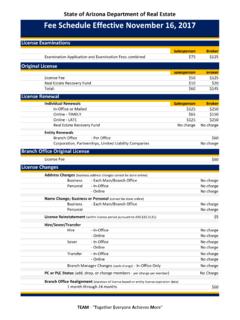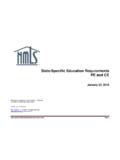Transcription of Alcohol and Other Drug Prevention on College Campuses ...
1 Bklet cvr 2008 color 235 Final 9/26/08 7:48 AM Page 1. Model Programs The Department of education 's mission is to promote student achievement and preparation for global competitiveness by fostering educational excellence and ensuring equal ac c e s s . Department of education Alcohol and Other drug Prevention on College Campuses Model Programs Department of education Office of Safe and drug -Free Schools This publication was funded by the Office of Safe and drug -Free Schools at the Depart- ment of education under contracts number ED-99-CO-0094 and ED-04-CO-0137 with education Development Center, Inc. The contracting officer's representative was Richard Lucey, Jr. The content of this publication does not necessarily reflect the views or policies of the Department of education , nor does the mention of trade names, commercial products, or organizations imply endorsement by the government. This publication also contains hyperlinks and URLs for information created and maintained by private orga- nizations.
2 This information is provided for the reader's convenience. The Department of education is not responsible for controlling or guaranteeing the accuracy, relevance, timeli- ness, or completeness of this outside information. Further, the inclusion of information or a hyperlink or URL does not reflect the importance of the organization, nor is it intended to endorse any views expressed, or products or services offered. Department of education Margaret Spellings Secretary Office of Safe and drug -Free Schools Deborah A. Price Assistant Deputy Secretary First printed 2000; updated November 2002 and September 2008. This report is in the public domain. Authorization to reproduce it in whole or in part is granted. While permission to reprint this publication is not necessary, the citation should be: Department of education , Office of Safe and drug -Free Schools, Alcohol and Other drug Prevention on College Campuses : Model Programs, Washington, , 2008. To order copies of this report, write to: ED Pubs, education Publications Center, Department of education , P.
3 O. Box 1398, Jessup, MD 20794-1398;. or fax your request to: 301-470-1244;. or e-mail your request to: or call in your request toll-free: 1-877-433-7827 (1-877-4-ED-PUBS). If 877. service is not yet available in your area, call 1-800-872-5327 (1-800-USA-LEARN). Those who use a telecommunications device for the deaf (TDD) or a teletypewriter (TTY) should call 1-800-576-7734. or order online at: This report is also available on the Department's Web site at: offices/OSDFS. On request, this publication is available in alternate formats, such as Braille, large print, audiotape, or computer diskette. For more information, please contact the Department's Alternate Format Center at 202-260-0852 or 202-260-0818. Contents Why Be Concerned? .. 1. The Scope of the Problem .. 2. What Colleges Are Doing to Address Alcohol and Other drug 4. Programs and Policies That Make a Difference .. 4. Campuses With Award-winning Programs .. 6. Auburn University .. 7. Boston College .. 8. Bowling Green State University.
4 9. George Mason University .. 10. Gonzaga University .. 11. Grand Valley State University .. 12. Hobart and William Smith Colleges .. 13. Hobart and William Smith Colleges .. 14. Lehigh University .. 15. Loyola Marymount University .. 16. Massachusetts Institute of Technology .. 17. Michigan State University .. 18. Montclair State University .. 19. Rutgers University .. 20. San Diego State University .. 21. Southwestern Indian Polytechnic Institute .. 22. Syracuse University .. 23. The Ohio State University .. 24. The Pennsylvania State University .. 25. The State University of New York at New Paltz .. 26. iii University at Albany, State University of New York .. 27. University at Albany, State University of New York .. 28. University of Arizona .. 29. University of Arizona .. 30. University of Chicago .. 31. University of Missouri Columbia .. 32. University of Missouri Columbia .. 33. University of Nebraska Lincoln .. 34. University of Northern Colorado .. 35. University of Pennsylvania.
5 36. Utah State University .. 37. Virginia Commonwealth University .. 38. Washington State University .. 39. Western Washington University .. 40. iv Why Be Concerned? College can and should be an exciting, enriching experience. To help ensure that it will be, students and their parents will want to choose a College that fosters students' academic and social development and promotes campus and community safety. One critical element to consider is the Alcohol and Other drug culture of a campus. Far too often, Alcohol and Other drug abuse results in tragedy. Deaths from Alcohol poisoning and from Alcohol -related incidents have occurred on all types of Campuses in recent years elite schools and lesser-known institutions; large schools and small ones; urban, small town, and rural schools. In addition, Alcohol and Other drug abuse is a factor in the majority of accidents, injuries, vandalism, and crime on College Campuses and is frequently a key factor when students encounter problems with their course work.
6 Although the majority of College students avoid the unsafe use of Alcohol and Other drugs, they are still likely to suffer the consequences of the high-risk behaviors of their peers. Students who engage in high-risk drinking and Other drug use are not just harming themselves but also those around them, and not just occasionally but with truly disturbing frequency. By becoming informed about Alcohol and Other drug Prevention efforts on College Campuses , prospective College students can increase the likelihood that they will avoid Alcohol - and Other drug -related problems and have their dreams and expectations for College met. 1. Alcohol and Other drug Prevention on College Campuses The Scope of the Problem Studies confirm that College Campuses continue to experience significant problems related to student Alcohol and Other drug abuse. Although the vast majority of College students are under the legal drinking age of 21, Alcohol remains the clear drug of choice and the one that contributes to a wide range of problems.
7 The 2006 Monitoring the Future Survey, conducted at colleges and universities across the country, found that of all College students, approximately 40 percent have engaged in high-risk drinking. Fur- thermore, the following percentages of students used various Other drugs during 2005: marijuana ( percent); ecstasy ( percent);. amphetamines ( percent); hallucinogens ( percent); cocaine ( percent); methamphetamine ( percent); and tranquilizers ( percent). Such illicit drug use has been a factor in a number of serious adverse consequences, such as hospitalizations for overdoses and deaths. The National Institute on Alcohol Abuse and Alcoholism (NIAAA) published a report in April 2002, updated in 2005, that suggests a strong relationship between Alcohol and Other drug abuse and a variety of negative consequences for students. The report estimates that each year 1,700 College students die from Alcohol -related unintentional injuries, including motor vehicle crashes. In addition, it further estimates that Alcohol is involved in 599,000 unintentional injuries, 696,000 assaults, and 97,000 cases of sexual assault and acquaintance rape among College students.
8 Alcohol abuse also creates academic problems among 25 percent of College students, such as earning lower grades, doing poorly on exams or papers, missing class, and falling behind. According to the NIAAA, fully 400,000 students had unprotected sex while under the influence of Alcohol and more than 100,000 were too intoxicated to know whether they consented to sexual intercourse. More than 150,000 students developed a health problem related to Alcohol , and between and percent of students attempted suicide because of Alcohol or Other drug abuse. Finally, 11 per- cent of students damaged property and million students drove while under the influence of Alcohol . 2. It is not only those who engage in high-risk drinking or Other drug use who suffer adverse consequences from student Alcohol abuse. Students who abstain, or who drink legally and moderately, fre- quently suffer secondhand effects from the behavior of Other students who drink too much. Even though the majority of College students are not high-risk drinkers and one-fifth abstain from all Alcohol use, more than three-quarters of the students living in residence halls, fraternities, or sororities report that they have experienced at least one secondhand effect due to another student's drinking.
9 College Students Encounter Problems When Others Drink Too Much*. % had study or sleep interrupted % had to take care of a drunken student had been insulted or humiliated % experienced an unwanted sexual advance (women). % had a serious argument or quarrel % had property damaged % had been pushed, hit, or assaulted % had been a victim of sexual assault or date rape (women). *Figures apply only to abstaining and non-heavy drinking students in dorms and fraternity or sorority houses. Source: Wechsler, H.; Lee, J. E.; Kuo, M.; and Lee, H. References Hingson, R.; Heeren, T.; Winter, M.; and Wechsler, H. Magnitude of Alcohol -Relat- ed Mortality and Morbidity Among College Students Ages 18 24: Changes from 1998 to 2001. Annual Review of Public Health, 26, 259 279, 2005. Johnston, L. D.; O'Malley, P. M.; Bachman, J. G.; and Schulenberg, J. E. Monitoring the Future National Survey Results on drug Use, 1975 2005: Volume II, College Students and Adults Ages 19 45 (NIH Publication No.)
10 06-5884) (Bethesda, Md.: National Institute on drug Abuse, 2006). Task Force of the National Advisory Council on Alcohol Abuse and Alcoholism, National Institute on Alcohol Abuse and Alcoholism. A Call to Action: Changing the Culture of Drinking at Colleges (Washington, : National Institutes of Health, 2002); NIAAA. statistics cited above in paragraph 3 are from A Snapshot of Annual High-Risk College Drink- ing Consequences at Wechsler, H.; Lee, J. E.; Kuo, M.; and Lee, H. College Binge Drinking in the 1990s: A Continuing Problem: Results of the Harvard School of Public Health 1999. College Alcohol Study. Journal of American College Health 48: 199 210, March 2000. 3. Alcohol and Other drug Prevention on College Campuses What Colleges Are Doing to Address Alcohol and Other drug Problems In response to growing awareness of and concern about Alcohol and Other drug problems, institutions of higher education are implementing policies and programs in an attempt to curb Alcohol and Other drug abuse and its associated negative consequences.




